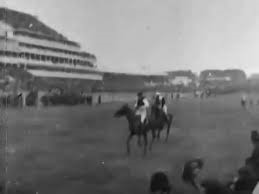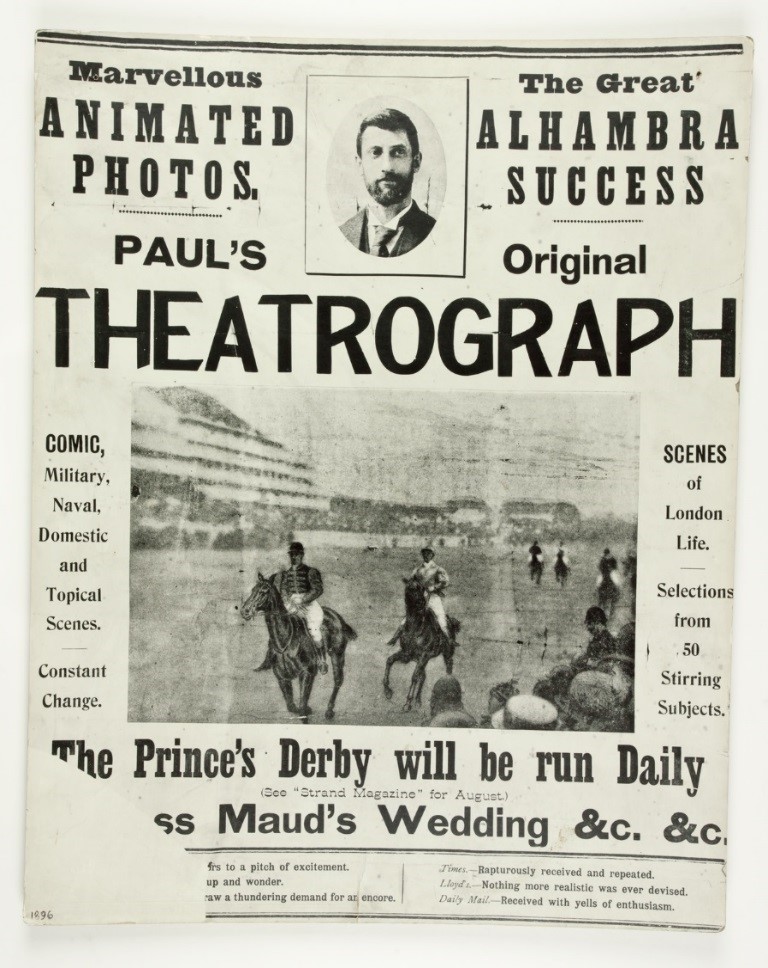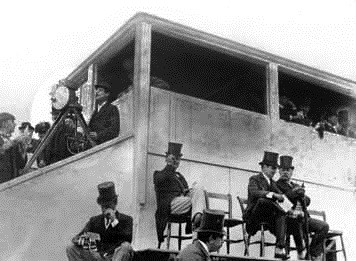
“But the greatest sensation is, beyond question, the Prince’s Derby of 1896, the most popular win the turf has ever known. Of course, Mr Paul didn’t know that the Prince of Wales was going to win the Derby; he merely went to get the finish of that great race… which should show to countless multitudes one of the most popular events of the Victorian age.”
—The Strand Magazine, vol. XII (July – December, 1896)
The writer of these words is clearly not only thrilled by the new spectacle of projected moving pictures, but particularly by the film of the 1896 Derby. Made even more thrilling in that the race was won by Persimmon, the horse belonging to the Prince of Wales (later King Edward VII).
The Paul mentioned above is Robert William Paul, who filmed the race that year—and also in 1895, but we’ll get to that in due course.

On 3 June 1896, filming from a position on the right-hand side of the course, with the grandstand in the background, the film captured the leading horses galloping past the finishing post. Almost immediately, crowds swarm onto the course, accompanied by several police officers who rather than try to hold back the multitude, seem to join in.
This can be considered as one of the earliest examples of newsreel footage—both for the subject matter but also for the speed in which it was made, printed and screened to an audience. Paul, always the businessman and entertainer, processed the film (made projectable positive prints from the original negative) overnight and showed it to audiences in two London theatres the very next day, 4 June 1896.
As the Strand journalist wrote with even greater excitement:
“Thus the same evening an enormous audience at the Alhambra Theatre witnessed the Prince’s Derby all to themselves amidst wild enthusiasm, which all but drowned the strains of ‘God Bless the Prince of Wales’, as played by the splendid orchestra. In short, the great race, as depicted by Mr Paul’s Animatographe, is a veritable marvel of modern photography and mechanism”
(The Animatographe was the name given to the projector at the Alhambra Theatre shows.)
Paul claimed that the film was so popular that the audience demanded three repetitions of it that night, with viewers standing on their seats as they sang.
As an aside, the head of Persimmon, the winning horse is now preserved at the National Horseracing Museum in Newmarket—which makes me think of a much later and very different film… But back to the Derby.
The film was so popular with audiences it received what we might now call an extended run. Here you can see a poster for the Palace Theatre, Croydon with the Prince’s Derby (along with other Robert Paul productions) topping the bill over other intriguing entertainments such as charming dancers and eccentric or athletic comedians. All in all, quite a night’s entertainment.

Back to my earlier mention of the 1895 Derby. Robert Paul and his then partner Birt Acres filmed the race in 1895. Now at the risk of offending racing enthusiasts I do find it a little difficult to tell one horse race from another when all you have to go on is a short film of the final moments. And seemingly I am not alone, as an online search will uncover many clips of the 1896 Derby, incorrectly identified as the 1895 race.
A simple rule of thumb to tell these two apart is the camera position: in the 1895 race the camera is filming from a much higher angle, giving a quite different view to the 1896 film. Here’s an image of Birt Acres in his elevated position with his camera ready to film in 1895.

The 1895 Derby film was lost for many years. A fascinating account of the excitement and frustration around the rediscovery of the film by Luke McKernan can be found in this blog post at The Bioscope.
Newsreel companies continued to film the Derby for years to come; probably the most famous is that of the 1913 race, showing the moment when Suffragette Emily Davison was trampled by King George V’s horse Anmer when she stepped onto the track.
Read more about Robert Paul and his role in the invention of cinema.
One comment on “Filming the Prince’s Derby, 1896”